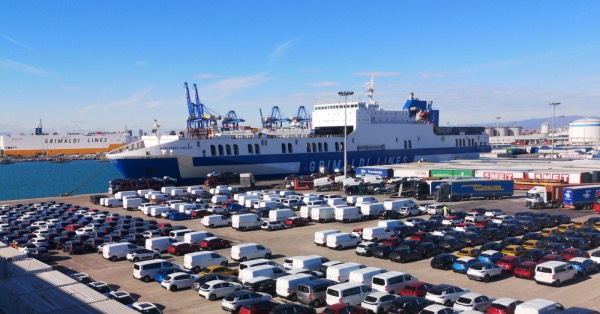The terminals of the Port Authority of Valencia handled 600,000 vehicles in 2022, 22% more than the previous year
Valenciaport handled 1 out of every 5 new unregistered vehicles in the Spanish port system
Italy, Belgium and Turkey are the main countries in this type of traffic, but the capillarity of Valenciaport also allows one vehicle to reach Ghana, two to India and 398 to Australia
This year, the positive trend continues. Between January and February, 99,987 cars were moved, 5% more than in 2022
In freight, and so far in 2023 (January and February), traffic has fallen by 14.5%ntering or leaving the Port of Valencia by train grew by 8.62% between January and February, continuing the dynamic of recent months
Valenciaport continues to maintain the weight of 40% of Spanish maritime traffic import/export
Valencia Valenciaport managed a total of 599,657 units of new unregistered vehicles in 2022, 110,992 more than in the previous year, according to statistical data from Puertos del Estado. 1 out of every 5 vehicles have been moved through the ports managed by the Port Authority of Valencia (APV). In relative terms, this represents a growth of 22.7%, compared to the national average of 13.2%, in a year 2022 in which traffic has increased. In fact, 2,735,910 against 2,416,472 in 2021 of cars, buses and lorries have been registered in the Spanish port system, which includes loading, unloading and transit.
Valenciaport is at the head of this type of traffic among the ports of interest in Spain, ahead of Barcelona, Vigo and Santander, being the one that has grown the most of these four enclosures. Barcelona operated a total of 588,572 vehicles in 2022 (+18.3%), Vigo handled 474,791 (-5.6%) and Santander handled 322,865 (+16.2%). Next in position are the Pasaia enclosures with 239,955 (+14.6%) and Tarragona with 172,164 (+27%).
About the ports of the PAV, it should be noted that the Port of Valencia handled more than 485,000 units, 23% more than in 2021, while the Sagunto site handled 115,000 vehicles, representing an increase of 18.5% over the previous year. The international situation, with the shortage of semiconductors and components or the rise in fuel prices, has marked the production of vehicles all over the world, hence the fact that the ports have not yet recovered the pre-Covid figures (in 2019 the Spanish port system handled 3,405,324 cars compared with 2,735,910 in 2022).
The docks of Sagunto and Valencia have handled practically 1 out of every 5 new unregistered vehicles – 22% – of the total of the Spanish port system, including loading, unloading, transits and transhipments. According to APV data, of these 600,000 units, more than 125,000 have their destination/origin in Italy, equivalent to 21%. This is followed by Belgium, with which 19%, or 114,000 units, are handled. In third place, with 13% and nearly 80,000 vehicles, is Turkey. Exchanges in Spain amounted to 74,000 units, while those with the United Kingdom amounted to 39,000, followed by Japan and the United States with 26,000 units respectively.
But the capillarity of Valenciaport also serves to take one unit to Ghana, two to India and 398 to Australia, the latter being the most distant country that has loaded vehicles in Valencia to be driven on the remote and arid roads of the Australian outback or desert.
The positive trend in vehicle movements contrasts with freight traffic in general
According to data from the PAV’s Statistical Bulletin for February of this year, this positive trend in the movement of automobiles continues in a month when the world economy is characterised by uncertainty. Thus, between January and February, 99,987 units were moved, 5% more than in 2022. In the case of the Valencian precinct, 80,803 units were handled, 2% more than in the first two months of last year, while Sagunto handled 19,184, 20.5% more.
The complex international situation marked by the war in Ukraine, the rise in the cost of raw materials and high inflation is reflected in Valenciaport’s traffic in the first two months of the year. Thus, between January and February of this year, 11.6 million tonnes have been mobilised, 14.5% less than in 2022, while containers have reached 721,544, representing a decrease of 18.47%.
The traffics reflect the slowdown in activity in the productive sectors. Full containers dedicated to exports fell by 12.56%, imports fell by 8.86% and transit containers fell by 26.28%. Nevertheless, Valenciaport continues to maintain the 40% weight of import/export of Spanish maritime traffic, while transhipment has lost weight since last year.
In these first two months of the year, in addition to the positive figure for cars moved, it is worth noting the 5.41% increase in ro-ro traffic to over 2 million tonnes. Valenciaport’s commitment to the railway continues to bear fruit. Thus, in the first two months of the year, rail traffic has moved 543,578 tonnes compared to 500,454 tonnes in 2022, which represents an increase of 8.62%. TEUs that have entered or left by train have also increased by 9.27%.
With regard to freight traffic by sector, the general trend is a decrease in the majority. On the other hand, the dynamism of cereals and their flours stands out, with a 14.43% increase in traffic and automobiles and their parts by 36.37%. By countries, Italy is the main trading partner with 1,163,430 tonnes, highlighting the 18.3% increase in cargo in the first two months of the year, although total traffic fell by 10% due to transit. India, with a growth of 34.46% and Mexico with an increase of 22.79% are the most dynamic countries. In terms of TEUs, China continues to be the leading country with 77,502 containers despite the 19.52% decrease.









































